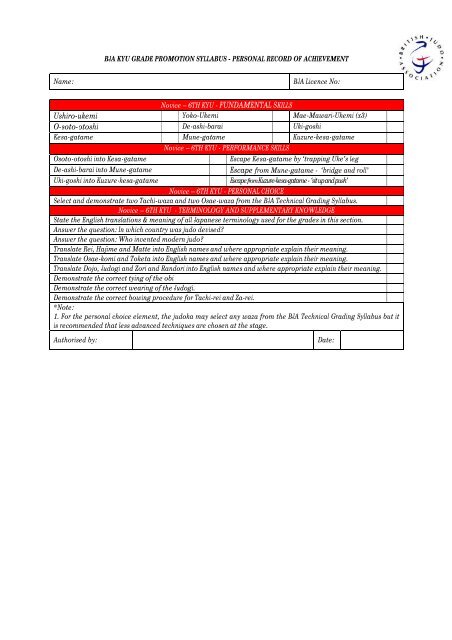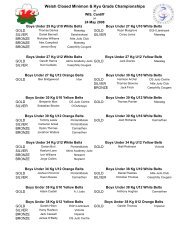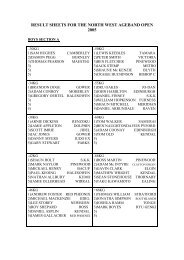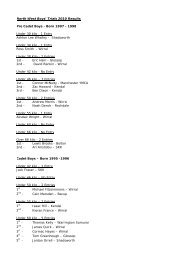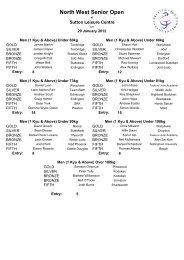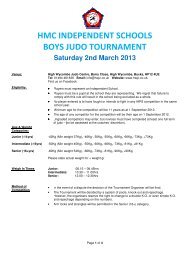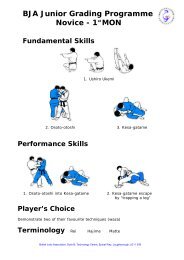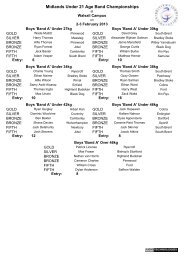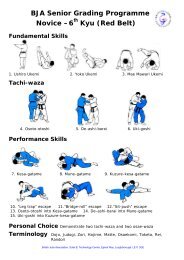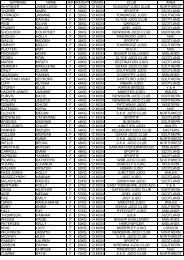Record of achievement - British Judo Association
Record of achievement - British Judo Association
Record of achievement - British Judo Association
You also want an ePaper? Increase the reach of your titles
YUMPU automatically turns print PDFs into web optimized ePapers that Google loves.
BJA KYU GRADE PROMOTION SYLLABUS - PERSONAL RECORD OF ACHIEVEMENTName:BJA Licence No:Novice – 6TH KYU - FUNDAMENTAL SKILLSUshiro-ukemi Yoko-Ukemi Mae-Mawari-Ukemi (x3)O-soto-otoshi De-ashi-barai Uki-goshiKesa-gatame Mune-gatame Kuzure-kesa-gatameOsoto-otoshi into Kesa-gatameDe-ashi-barai into Mune-gatameUki-goshi into Kuzure-kesa-gatameNovice – 6TH KYU - PERFORMANCE SKILLSEscape Kesa-gatame by ‘trapping Uke’s legEscape from Mune-gatame - ‘bridge and roll’Escape from Kuzure-kesa-gatame - ‘sit up and push’Novice – 6TH KYU - PERSONAL CHOICESelect and demonstrate two Tachi-waza and two Osae-waza from the BJA Technical Grading Syllabus.Novice – 6TH KYU - TERMINOLOGY AND SUPPLEMENTARY KNOWLEDGEState the English translations & meaning <strong>of</strong> all Japanese terminology used for the grades in this section.Answer the question: In which country was judo devised?Answer the question: Who invented modern judo?Translate Rei, Hajime and Matte into English names and where appropriate explain their meaning.Translate Osae-komi and Toketa into English names and where appropriate explain their meaning.Translate Dojo, <strong>Judo</strong>gi and Zori and Randori into English names and where appropriate explain their meaning.Demonstrate the correct tying <strong>of</strong> the obiDemonstrate the correct wearing <strong>of</strong> the <strong>Judo</strong>gi.Demonstrate the correct bowing procedure for Tachi-rei and Za-rei.*Note:1. For the personal choice element, the judoka may select any waza from the BJA Technical Grading Syllabus but itis recommended that less advanced techniques are chosen at the stage.Authorised by:Date:
BJA KYU GRADE PROMOTION SYLLABUS - PERSONAL RECORD OF ACHIEVEMENTName:BJA Licence No:6TH KYU – 5TH KYU - FUNDAMENTAL SKILLSMae Ukemi Tate-shiho-gatame Kami-shiho-gatameTai-otoshiIppon-seoi-nageO-uchi-gariYoko-shiho-gatame6TH KYU – 5TH KYU - PERFORMANCE SKILLSO-uchi-gari into Tate-shiho-gatameEscape from Kami-shiho-gatame -‘action/re-action’Ippon-seoi-nage into Kami-shiho-gatameTai-otoshi into Yoko-shiho-gatameTurnover into Kesa-gatame (Uke in “all fours” position)Turnover into Mune-gatame (Uke “all fours” position)Turnover into Yoko-shiho-gatame (Uke in prone position)Escape from Tate-shiho-gatame - ‘bear hug roll’Escape from Yoko-shiho-gatame - ‘trap, bridge and roll’Demonstrate the right and left standard gripsDemonstrate alternatives to the right and left standard grips6TH KYU – 5TH KYU - PERSONAL CHOICESelect and demonstrate two Tachi-waza and one Osaekomi-waza from the BJA Technical Grading Syllabus.6TH KYU – 5TH KYU - RANDORIDemonstration <strong>of</strong> Nage-komi in easy Randori with a co-operative partner6TH KYU – 5TH KYU - TERMINOLOGY AND SUPPLEMENTARY KNOWLEDGEState the English translations & meaning <strong>of</strong> all Japanese terminology used for the grades in this section.Give two examples <strong>of</strong> actions against the contest rules.*Notes:1. Nage-komi is introduced for this grade. It is to be demonstrated in the form <strong>of</strong> light Randori which be <strong>of</strong>approximately two minutes duration with each judoka throwing alternately. Although throws may be repeated, theexaminer will expect to see a variety and, if possible, to both right and left sides.2. Kumi-kata is a requirement for this grade and the judoka is required to demonstrate the standard grips andalternatives.3. For the personal choice element, the judoka may select any waza from the BJA Technical Grading Syllabus but itis recommended that less advanced techniques are chosen at this stage.Authorised by:Date:
BJA KYU GRADE PROMOTION SYLLABUS - PERSONAL RECORD OF ACHIEVEMENTName:BJA Licence No:5TH KYU —4TH KYU - FUNDAMENTAL SKILLSTsuri-komi-goshi Morote-seoi-nage Ko-soto-gakeO-goshi O-soto-gari Ko-soto-gariSeoi-otoshiO-uchi-gari into Ko-uchi-gariKo-uchi-gari into O-soto-gari/gakeO-uchi-gari countered by Tsuri-komi-goshiKo-uchi-gari into Morote-seoi-nageIppon-seoi-nage into Ko-uchi-gariO-uchi-gari countered by Tsuri-komi-goshiAny technique as a combination with Seoi-otoshiKo-uchi-gariAny technique as a combination with Ko-uchi-gari5TH KYU —4TH KYU - PERFORMANCE SKILLSTai-otoshi countered by Ko-soto-gariEscape from Kesa-gatame using ‘bridge and roll’Escape into Kesa-gatame ‘from between Uke’s legs’Escape into Yoko shiho gatame ‘from between Uke’s legs’Arm roll with Uke behind ToriArm roll in front <strong>of</strong> Uke(face to face)Turn over into Tate-shiho-gatame5TH KYU —4TH KYU - PERSONAL CHOICESelect and demonstrate three-waza (two Tachi-waza and one Ne-waza) from the BJA Technical GradingSyllabus and demonstrate them as a combination, a counter and as a transition into Ne-waza.5TH KYU —4TH KYU - RANDORIDemonstration <strong>of</strong> attacking and defending in light Randori with a co-operative partner.5TH KYU —4TH KYU - TERMINOLOGY AND SUPPLEMENTARY KNOWLEDGEState the English translations & meaning <strong>of</strong> all Japanese terminology used for the grades in this sectionandmust be able to discuss with the Examiner the reasons for their choice <strong>of</strong> technique, grip etc.Translate Waza-ari-awasete-ippon, Tori & Uke and where appropriate explain their meaning.Translate Shido and Han-soku-make and where appropriate explain their meaning.Translate Hiki-wake and Hantei and where appropriate explain their meaning.Demonstrate the referees signals for Matte, Osae-komi, Toketa, Adjusting <strong>Judo</strong>giDemonstrate the proper procedures for coming onto and leaving the mat during a contest.Give two examples <strong>of</strong> actions (not grips) against the contest rules.Give two examples <strong>of</strong> grips against the contest rules for negative or safety reasons.*Notes:1. Randori is introduced for this grade. It is to be demonstrated in the form <strong>of</strong> light Randori <strong>of</strong> approximately threeminutes duration. The examiner will expect to see a variety <strong>of</strong> waza and Kumi-kata and, if possible, throws to bothright and left sides.2. For the personal choice element, techniques must be demonstrated in an appropriate practical situation thatincludes attacking opportunity, best grip and appropriate movement.Authorised by:Date:
BJA KYU GRADE PROMOTION SYLLABUS - PERSONAL RECORD OF ACHIEVEMENTName:BJA Licence No:4TH KYU —3RD KYU - FUNDAMENTAL SKILLSHarai-goshi Hane-goshi Waki-gatameUchi-mata Okuri-ashi-barai Hiza-gatameHiza-guruma Morote-eri-seoi-nage Juji-gatameSasae-tsuri-komi-ashiJuji-gatame – sit back entryJuji-gatame – over the shoulder entryUde-gatame4TH KYU —3RD KYU - PERFORMANCE SKILLSJuji-gatame – roll over entryJuji-gatame – entry from beneath4TH KYU —3RD KYU - PERSONAL CHOICESelect four techniques from the BJA Technical Grading Syllabus and demonstrate them individually and as aseries <strong>of</strong> combinations and counters.4TH KYU —3RD KYU - RANDORIDemonstration <strong>of</strong> attacking, defence, avoidance and continuous attacking performance skills inTachi-waza and Ne-waza in Randori with a co-operative partner4TH KYU —3RD KYU - TERMINOLOGY AND SUPPLEMENTARY KNOWLEDGEState the English translations & meaning <strong>of</strong> all Japanese terminology used for the grades in this section andmust be able to discuss with the Examiner the reasons for their choice <strong>of</strong> technique, grip etc.*Notes:1. During the Randori demonstration the player will be required to demonstrate knowledge <strong>of</strong> basic performanceskills e.g. Kumi-kata, Renzoku-waza, Renraku-waza and Kaeshi-waza. The duration <strong>of</strong> the Randori will beapproximately four minutes.2. For the personal choice element, techniques must be demonstrated in an appropriate practical situation thatincludes attacking opportunity, best grip and appropriate movement. Demonstrations must include twocombinations, two counters and two transitions into Ne-waza. Combinations and counters can be either Tachiwazaor Ne-waza or a combination <strong>of</strong> both. Techniques must be demonstrated in an appropriate practical situationthat includes attacking opportunity, best grip and appropriate movement. It is expected that the player will selectappropriate techniques which will allow for the demonstration <strong>of</strong> the more advanced combinations and counters.3. Kansetsu-waza is introduced for this grade and the demonstrations must be made in a controlled manner withspecial attention being paid to the safety <strong>of</strong> Uke.Authorised by:Date:
BJA KYU GRADE PROMOTION SYLLABUS - PERSONAL RECORD OF ACHIEVEMENTName:BJA Licence No:3RD KYU – 2ND KYU - FUNDAMENTAL SKILLSKoshi-guruma Soto-kibusu-gaeshi Okuri-eri-jimeTani-otoshi Kata-guruma Nami-juji-jimeYoko-guruma Morote-gari Gyaku-juji-jimeTomoe-nage Soto-ashi-dori-ouchi-gari Ude-garamiKata-uchi-ashi-doriUde-garami from Kuzure-kesa-gatameYoko-kata-guruma-otoshiKoshi-jime - (Uke makes Seoi-otoshi dropping attack)Kata-te-jime - Uke in all fours positionUchi-kibusu-gaeshi3RD KYU – 2ND KYU - PERFORMANCE SKILLSNami-juji-jime - Uke on top between Tori’s legsGyaku-juji-jime - Uke on top between Tori’s legsOkuri-eri-jime - (Uke makes Seoi-otoshi dropping attack)Introduction to performance Kumi-kata (see TLP 12-13 Mon)3RD KYU – 2ND KYU - PERSONAL CHOICE(PC 1) Select four techniques from the BJA Technical Grading Syllabus and demonstrate and demonstratethem individually and then as a series <strong>of</strong> combinations and counters. *See also note below.(PC 2) Demonstrate any two sets <strong>of</strong> the Nage-no-kata or any two sets <strong>of</strong> the Katame-no-kata or either <strong>of</strong> firsttwo sets <strong>of</strong> the Go-no-sen-no-kata.3RD KYU – 2ND KYU – RANDORIDemonstration <strong>of</strong> attacking defence, avoidance, continuous attacking performance skills in Tachi-waza andNe-waza in Randori with a co-operative partner.3RD KYU – 2ND KYU - TERMINOLOGY AND SUPPLEMENTARY KNOWLEDGEState the English translations & meaning <strong>of</strong> all Japanese terminology used for the grades in this section andmust be able to discuss with the Examiner the reasons for their choice <strong>of</strong> technique, grip etc.*Notes:1. During the Randori demonstration the player will be required to demonstrate knowledge <strong>of</strong> basic performanceskills e.g. Kumi-kata, Renzoku-waza, Renraku-waza and Kaeshi-waza. The duration <strong>of</strong> the Randori will beapproximately four minutes.2. For the personal choice element, techniques must be demonstrated in an appropriate practical situation thatincludes attacking opportunity, best grip and appropriate movement. Demonstrations must include twocombinations, two counters and two transitions into Ne-waza. Combinations and counters can be either Tachiwazaor Ne-waza or a combination <strong>of</strong> both. Techniques must be demonstrated in an appropriate practical situationthat includes attacking opportunity, best grip and appropriate movement. t is expected that the player will selectappropriate techniques which will allow for the demonstration <strong>of</strong> the more advanced combinations and counters.3. Kata is <strong>of</strong>fered as personal choice for this grade. Demonstrations must be performed in the traditional mannerand include the formal opening and closing bowing procedures.4. Personal choice is first from PC1 and then additionally from PC2.Authorised by:Date:
BJA KYU GRADE PROMOTION SYLLABUS - PERSONAL RECORD OF ACHIEVEMENTName:BJA Licence No:2ND KYU – 1ST KYU - FUNDAMENTAL SKILLSSode-tsuri-komi-goshi Ushiro-goshi Kata-ha-jimeTe-guruma Ura-nage Hadaka-jimeRyo-hiza-seoi-otoshi Uki-otoshi Kata-te-ashi-koshi-jimeSumi-gaeshi Soto-maki-komi San-gaku-jimeYoko-gakeKo-uchi-gake-mata-maki-komiKnowledge <strong>of</strong> performance forms <strong>of</strong> selected techniquesDemonstrate any two variations <strong>of</strong> Sumi-gaeshiSan-gaku-gatame – complex entrySan-gaku-jime – complex entryYoko-tomoe-nageKata-hiza-te-ouchi-gake-ashi-dori2ND KYU – 1ST KYU - PERFORMANCE SKILLSSan-gaku-osae-gatame – turnover and holdHadaka-jime – Uke in prone positionKata-ha-jime – Uke “all fours” position2ND KYU – 1ST KYU - PERSONAL CHOICE(PC 1) Select four techniques from the BJA Technical Grading Syllabus and demonstrate and demonstratethem individually and then as a series <strong>of</strong> combinations and counters.(PC 2) Demonstrate any three sets <strong>of</strong> the Nage-no-kata or any three sets <strong>of</strong> the complete Katame-no-kata orthe complete Go-no-sen-no-kata.2ND KYU – 1ST KYU - RANDORIDemonstration <strong>of</strong> attacking defence, avoidance, continuous attacking performance skills in Tachi-waza andNe-waza in Randori with a co-operative partner.2ND KYU – 1ST KYU - TERMINOLOGY AND SUPPLEMENTARY KNOWLEDGEState the English translations & meaning <strong>of</strong> all Japanese terminology used for the grades in this section andmust be able to discuss with the Examiner the reasons for their choice <strong>of</strong> technique, grip etc.Give three examples <strong>of</strong> any <strong>of</strong> the penalties in Article 27.*Notes:1. During the Randori demonstration the player will be required to demonstrate knowledge <strong>of</strong> basic performanceskills e.g. Kumi-kata, Renzoku-waza, Renraku-waza and Kaeshi-waza. The duration <strong>of</strong> the Randori will beapproximately four minutes.2. For the personal choice element, techniques must be demonstrated in an appropriate practical situation thatincludes attacking opportunity, best grip and appropriate movement. Demonstrations must include twocombinations, two counters and two transitions into Ne-waza. Combinations and counters can be either Tachiwazaor Ne-waza or a combination <strong>of</strong> both. Techniques must be demonstrated in an appropriate practical situationthat includes attacking opportunity, best grip and appropriate movement. It is expected that the player will selectappropriate techniques which will allow for the demonstration <strong>of</strong> the more advanced combinations and counters.3. Kata is <strong>of</strong>fered as personal choice for this grade. Demonstrations must be performed in the traditional mannerand include the formal opening and closing bowing procedures.4. Personal choice is first from PC1 and then additionally from PC2.Authorised by:Date:
BJA KYU MON GRADE PROMOTION SYLLABUS - PERSONAL RECORD OF ACHIEVEMENTCONVERSION FROM THE JUNIOR MON GRADE SYLLABUSPlayers <strong>of</strong> 14 years <strong>of</strong> age and above who hold a junior (Mon) grade may, if they wish, convert to the Senior (Kyu)grade. The following table will be used for all Junior (Mon) grade conversions. It may appear that the Junior (Mon)grade is converting to a lower level <strong>of</strong> examination; however, this is to allow for a period <strong>of</strong> assimilation into theKyu grade system. Players holding a Junior (Mon) grade will be converted to the senior (Kyu) grade on reaching theage <strong>of</strong> 18.Mon Grade Kyu Grade Mon Grade Kyu Grade1st Mon to Novice2nd Mon to Novice3rd Mon to 6th Kyu4th Mon to 6th Kyu5th Mon to 6th Kyu6th Mon to 5th Kyu7th Mon to 5th Kyu8th Mon to 5th Kyu9th Mon to 4th Kyu10th Mon to 4th Kyu11th Mon to 4th Kyu12th Mon to 3rd Kyu13th Mon to 3rd Kyu14th Mon to 3rd Kyu15th Mon to 2nd Kyu16th Mon to 2nd Kyu17th Mon to 2nd Kyu18th Mon to 1st KyuCONVERSION FROM THE 9 KYU GRADE SYLLABUSPlayers graded under the 9 Kyu Grade Promotion Syllabus will have their grade converted according to thefollowing table. There is no charge for this conversion and the conversion may be completed at any time prior tothe first grading attempt under this syllabus. The player’s record book may be updated by anyone with theauthority to grade as previously specified.- -}}}}}9th Kyu8th Kyu7th Kyu6th Kyu5th Kyu4th Kyu3rd Kyu2nd Kyu1st Kyu9 Kyu Syllabus to 6 Kyu Syllabus6th Kyu (White Belt)5th Kyu (Yellow Belt)4th Kyu (Orange Belt)3rd Kyu (Green Belt)2nd Kyu (Blue Belt)1st Kyu (Brown Belt)


